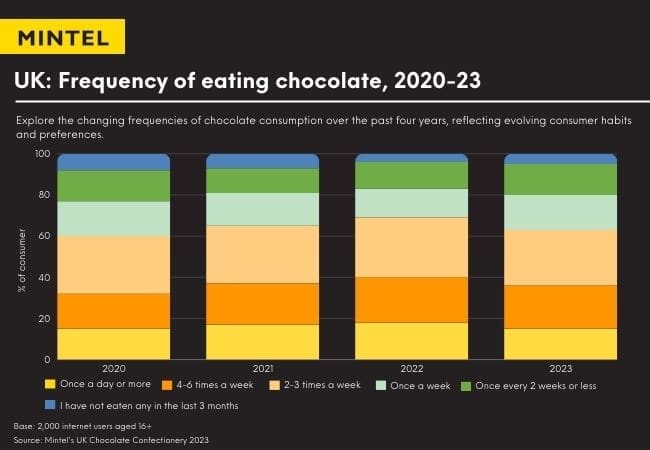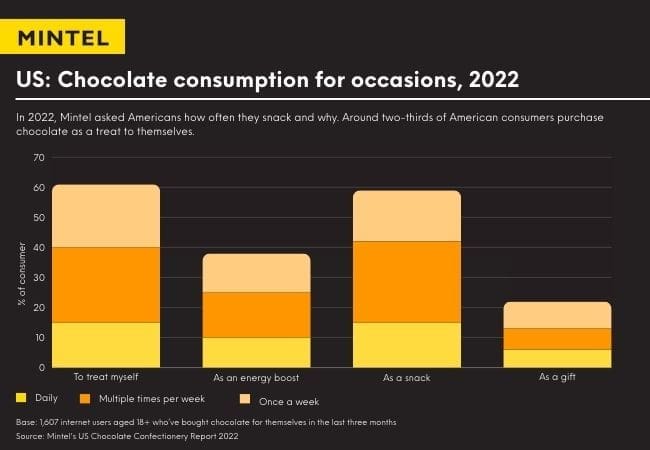Whether you like a single-serving chocolate bar or enjoy gifting selection boxes for special occasions, most of us are chocolate lovers. It is a staple sweet treat in countries all around the world, but which of us eats the most chocolate? And are our chocolate consumption behaviours changing over time? Mintel’s research into chocolate confectionery around the world uncovers behaviours and attitudes towards that delicious confection in different nations to find out which countries eat the most chocolate.
Chocolate Consumption Around the World
Let’s have a closer look at which countries around the world eat the most chocolate and how these chocolate consumption trends have changed in recent years.
British Chocolate Consumption
The UK is a nation of chocolate lovers, as evidenced by the fact that 95% of Brits eat chocolate. An impressive four in five British people eat chocolate once a week or more, making it a regular part of British diets. This has slightly decreased since 2022, with a shift towards eating chocolate only once every fortnight or less regularly than previously. But why are Brits eating less chocolate in 2023? One reason may be that the HFSS (High in Fat, Sugar, or Salt) products have faced tighter restrictions on where they can be located in stores since October 2022, so confectioneries including chocolate are less visible to consumers than previously. This has caused a decline in impulse chocolate purchasing, especially as in 2022 almost 7 in 10 British consumers declared that they impulsively buy chocolate on promotional deals. In 2023, however, only a third of British consumers said that they bought chocolate for themselves because it was on special offer.

German Chocolate Consumption
Germany is another nation of big chocolate consumers. In 2023, Mintel reported that three-quarters of German consumers eat chocolate at least once a week, with more than 10% eating chocolate once a day or more. More than half of German consumers agree that eating chocolate is an affordable way to improve their mood, and most prefer to buy chocolate blocks that can be eaten across multiple occasions. This tells us that eating chocolate is part of a regular routine for German consumers, rather than being an occasional and unpredictable treat.
In terms of which chocolates they eat, Germans aged under 44 are far more likely to purchase single-serve bars compared to older consumers, who prefer blocks. With three-quarters of consumers saying that smaller bars are better for trying different flavours, this suggests that younger consumers are more interested in novel varieties than older consumers.

American Chocolate Consumption
American consumption of chocolate confectionery falls slightly behind that of British consumers, as 3% fewer Americans have purchased chocolate of any kind in the last three months. However, Mintel’s research reveals that more than four out of five American consumers are eating the same amount or more chocolate than last year.
So, the US appears to be a stable market for chocolate confectionery, but in which circumstances are Americans tempted to purchase? Around two-thirds of American consumers purchase chocolate as a treat, compared to one-third who purchase chocolate as an energy boost, suggesting that chocolate consumption in the US is more commonly for pleasure than practicality. This is further reiterated by the fact that over half of the Americans who ate more chocolate in 2022 attributed it to an increased desire for indulgence.

Canadian Chocolate Consumption
Consumers in Canada, like those in other parts of the world, seem to have maintained their chocolate consumption levels. This holds true for Canada, where only one in five consumers are eating either more or less chocolate than last year, which causes overall chocolate consumption to balance out. While 9 in 10 Canadians eating chocolate regularly might seem like a large portion of the population, it is comparatively one of the world’s smaller chocolate consumers.
Regarding Canadian attitudes towards eating chocolate, it appears that consumers primarily appreciate the convenience of chocolate snacks, although some prefer to choose more healthy options. More than half of those eating less chocolate and candy in Canada in 2022 have consciously made an effort to reduce their sugar intake. On the other hand, two-thirds of those eating more chocolate and candy in 2022 did so as they are snacking more at home.

Looking Ahead with Mintel
The UK is undoubtedly one of the world’s most loyal and consistent consumers of chocolate, with the vast majority of the population eating chocolate regularly and enjoying a wide variety of chocolate types. Similarly, consumers in the United States are eating chocolate on a comparable level to recent years, with most of the population enjoying chocolate confectioneries. Comparatively, German and Canadian consumers eat less chocolate than their counterparts in Britain and America.
In countries where chocolate is a daily indulgence for most, as well as in those countries where it is enjoyed occasionally, the levels and frequency of chocolate consumption have remained steady in recent years. This signals that there is a certain loyalty and consistency in chocolate consumption, and populations are unlikely to drastically change in their chocolate consumption habits. Even in cases where some individuals may consume more or less chocolate than in previous years, the changes are balanced on both sides, resulting in an overall consistent level of consumption.
Take advantage of Mintel’s in-depth market research to sharpen your strategies and align with the latest trends in consumer behaviour. Explore our extensive Confectionery Market Research today.
Subscribe to our newsletter, Spotlight, to get free content and insights delivered directly to your inbox.
Sign up to Spotlight








